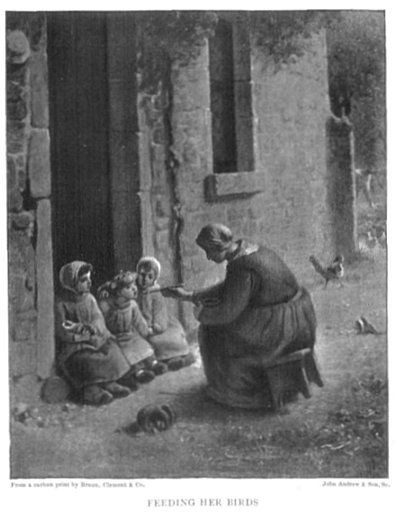








As we have already seen in the picture of the Woman Feeding Hens, the dooryard in French village homes is so shut in by walls, that it has the privacy of a family living-room. This was the arrangement in Millet's own home at Barbizon. The painter was among the fortunate ones who had a garden beyond the dooryard. At the other end of this was his studio, where he worked many hours of the day. It is said that he used to leave the door open that he might hear the children's voices at their play. Sometimes, indeed, he would call them in to look at his pictures, and was always much pleased when they seemed to understand and like them. We may be sure that he often looked across the garden to the dooryard where the family life was going on, and at such times he must have caught many a pretty picture. Perhaps our picture of this mother feeding her children was suggested in this way.
Three healthy, happy children have been playing about in the yard,—a girl of six, her younger sister, and a brother still younger. They are dressed simply, so as to enjoy themselves thoroughly without fear of injuring any fine clothes. All three wear long aprons and wooden sabots. The little girls have their flying hair confined in close bonnet caps tied under the chin. The boy rejoices in a round cap ornamented on top with a button. The sisters take great care of their little brother.
The toys are of a very rude sort and evidently of home manufacture. A cart is constructed of a board set on clumsy wheels. A doll is roughly shaped of wood and wrapped in a hood and blanket. There is a basket besides, in which one can gather bits of treasure picked up here and there in the yard.

By and by the play is interrupted by a familiar voice. The children look up and see their mother standing smiling in the doorway. A bowl which she has in her hand is still steaming, and an appetizing odor reminds them that they are hungry. The basket and the cart are hastily dropped, but not the doll, and they all run to the doorstep. The brother is placed in the middle and the sisters seat themselves on either side. The elder girl still holds her doll with maternal solicitude; the other two children clasp hands, and the sister's arm is put around the boy's neck.
Meanwhile the mother has seated herself directly in front of them, on a low stool such as is used by country people as a milking-stool. She tips it a little as she leans over to feed the children in turn from a long-handled wooden spoon. Of course the first taste is for the little brother, and he stretches out his neck eagerly, opening his mouth wide so as not to lose a drop. The sisters look on eagerly, the younger one opening her own mouth a little, quite unconsciously. An inquisitive hen runs up to see what good things there are to eat. In the garden beyond, the father works busily at his spading.
The name which Millet gave to this picture is the French word Becquée, which cannot be translated into any corresponding word in English. It means a beakful, that is, the food which the mother bird holds in her beak to give to the nestlings.
The painter had in mind, you see, a nestful of birds being fed. The similarity between the family and the bird life is closely carried out in the picture. The children sit together as snugly as birds in a nest. The mother bends toward them in a brooding attitude which is like the bird mother's. Her extended hand suggests a bird's beak, tapering to a sharp point at the end of the spoon. The young bird's mouth is wide open, and in pops the nice spoonful of broth! The house itself is made to look like a cosy little nest by the vine that embowers it. The sturdy stem runs up close by the doorstep and sends out over door and window its broad branches of beautiful green leaves.
And just as the father bird watches the nest from his perch on some branch of the tree, the father at work in the garden can look from time to time at the little family circle in the doorway. As in the picture of the Woman Feeding Hens, the house is built of stone covered with plaster. The door casing is of large ill-matched blocks of stone. The dooryard is made to appear much larger by the glimpse of the orchard we get through the gateway. No out-of-door picture is complete which does not show something of the beauty of nature. The dooryard itself would be a bare place but for the shady garden beyond.